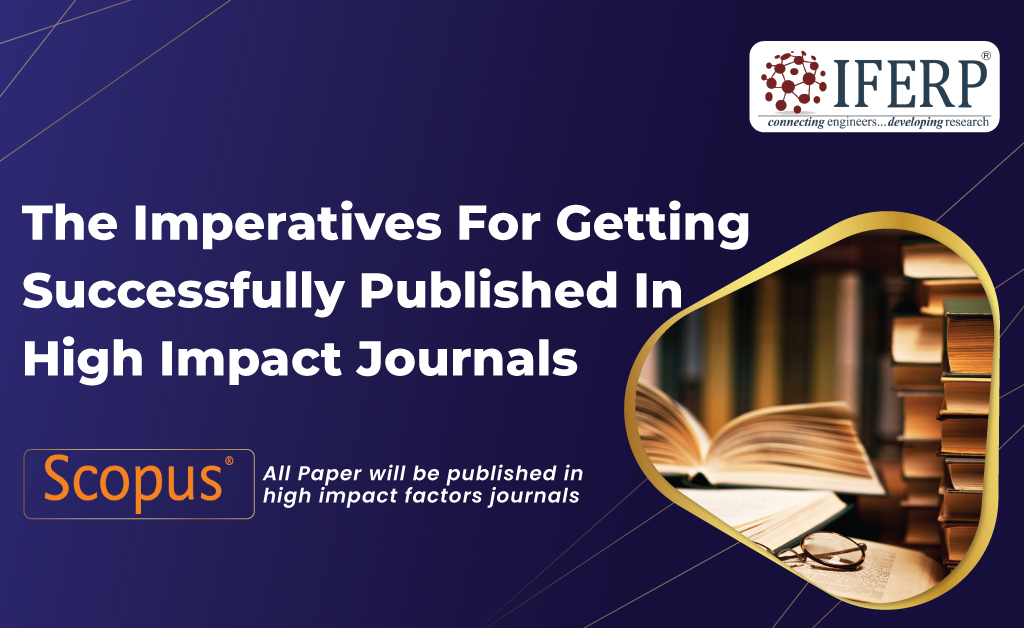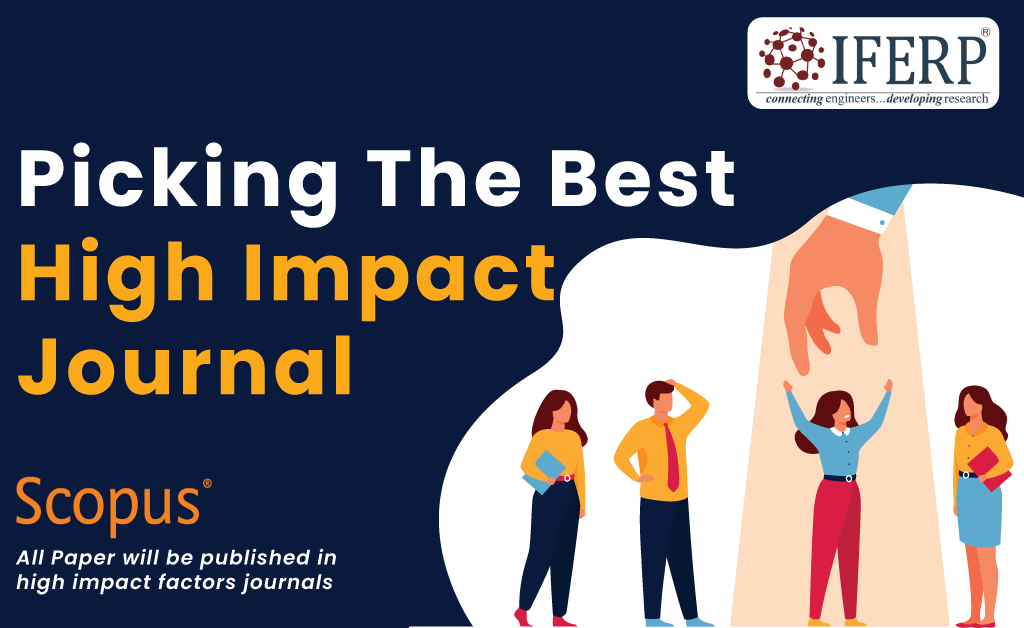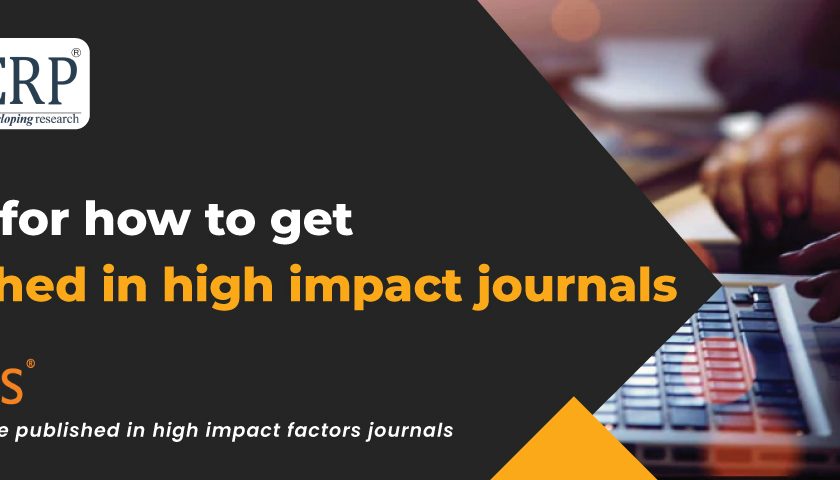High impact journals are the curators of scientific effort and progression. They aim to publish comprehensive research with lasting results that will stand up to the scrutiny of the global scientific community. As a direct consequence of this, these high-impact Scopus journals and publications are constantly trying to publish research articles that display significant research prowess and are likely to have a drastic, positive impact on the future of science. The features that these journals are always on the lookout for in manuscripts are originality and the capacity of the article to inspire new research and discussion.
As a budding researcher, one wants to publish their research in a high-impact journal. To do this, they must first produce innovative, high-quality research, which isn’t as easy as it sounds. Some important requirements must be met. Everyone from the most experienced of researchers to early career professionals tends to overlook these essentials and eventually end up publishing their work in low-impact journals where their work isn’t likely to get much attention. This article is intended to serve researchers as a guide for getting their work published successfully in high-impact journals.
The Imperatives For Getting Successfully Published In High Impact Journals
For new and young researchers, having a good team with an expert research director is essential. Research supervisors are essential in guiding us through the process of good research. They motivate new researchers to explore the best of us, keep us focused, and ensure success. As one begins their research journey, knowing what has already been researched and published earlier is essential. There is no incentive to simply rephrase existing articles.
- The Objective Of The Research – An Often Overlooked & Undervalued Factor
In general, the research question should come from the literature that has room for further research and debate. So it is better to avoid such an area which has been the subject of a lot of research. It is a good idea to select an active research area where the likelihood of having new ideas to explore is high. Backing up your research with data is essential. A research inquiry that is answered and backed by solid data, which is reproducible, is highly valued.
- Collaborators (Where Suitable) Help Immensely
Most types of research studies require the head researcher to have a good team to produce quality research. Working alone is time-consuming, voluntary, and in most cases, leads to poor quality research results. Collaborate with national/international groups. Multicenter studies have a high impact and influence and ensure that one’s research gets published in high-impact journals.
- As With Everything In Life – Planning Is A Must
Researchers must have a good study plan because it is an essential part of their research. If one’s research design is flawed, they may not be able to correct it when they are in the process of writing their manuscript, even if they have good writing skills. All publishers look for the quality of research design as the first parameter. If it is faulty, the manuscript will stop progressing and will eventually be rejected. It is always helpful to involve a statistician at the very start of commencing research as he/she will assist in defining a primary endpoint before beginning. Register in a high-level educational conference to learn more about this planning process.
- Impeccable Academic Writing Skills (Usually Comes With Practice But Nevertheless Is A Skill That Can Be Acquired Quickly)
Once the research work has concluded and some fantastic results have been obtained, it’s time to get the manuscript ready. The seemingly elusive mystery to successful academic writing, scientific or otherwise, is that the story should make sense. Every manuscript needs to have a beginning, a middle, and an end with a “to go” message. Other scientists reading the research should be able to deduce the research carried, why it has been carried out, what the discoveries of said research have been, and the interpretation thereof.
Good scientific writing requires clarity, conciseness, and logic. Every single paragraph in the manuscript should be able to stand alone while providing enough context to the paragraphs before and after it. Using simplistic language and following the rules of good punctuation, grammar, spelling, and style of language is key. Researchers should avoid all irrelevant information no matter how much they like it. Including only work that is relevant to the main topic of the research article and not deviating from the scientific questions meant to be addressed are all important things to bear in mind while writing. A lot of renowned high-impact journals organize their own set of guidelines where they go into detail about manuscript writing. The framework mentioned most often by these guidelines includes the following sections (in order of listing) –
- the Introduction,
- the Methods section,
- the Results section,
- the Discussion section,
- Acknowledgments,
- References, and
- lastly, the Tables and Figures section.
What To Do Before Submitting A Manuscript?
Before submitting a manuscript, it is imperative for researchers to realize that they only have one chance to catch the attention of the editor of the journal in which they wish to publish. They may lose this chance if they are not very careful in writing their manuscript. Enlisting the help of a lay colleague to review a manuscript and provide valuable feedback is suggested. Most importantly, the coworker can offer advice on whether the story is good and if the manuscript makes sense. Special attention should be paid to the title and abstract of the manuscript as well as the cover letter, which will be sent to the editor. The importance of these is explained below.

- The Significance Of The Title Of The Manuscript
The title is the very first part of a manuscript that offers considerable insight into the theme of research. As a result, it is quite important to choose a catchy title that substantially covers the gist of the research. The title has to accurately reflect the content of the manuscript and interest the reader to continue reading. A good title should be specific, convey the theme of the research, and highlight its essence. The title of a manuscript should be neither too long nor too short. Coming up with a few titles, thinking about how they describe the content of the manuscript, and choosing the one that works best, is a good strategy to adopt. Getting help from colleagues also works fine.
- The Importance Of The Abstract
An abstract reflects the main theme of the manuscript. Many editors only read the abstract of the manuscript they receive. Therefore, the abstract needs to be written in such a way that the editors should find it easy to understand what the entire gist of the research work is. What questions should a summary answer? In its simplest form, the summary should answer these key questions –
- What has been done?
- Why have the findings been?
- Why are these results useful and important?
- What is the scientific contribution?
Researchers who follow this simple format will find that their abstracts have turned out to be complete and distinguished. Being sure to follow the journal guidelines when writing the abstract and paying attention to the word limit for the abstract is crucial.
- The Vitality Of The Cover Letter
Getting the cover letter right is a crucial part of successfully getting published in a high-impact journal. Through their cover letters to editors, researchers are, in effect, trying to sell their articles to the journals that they’re applying to. They have to take great care to interest the editor and get their attention. Researchers often only have one chance to do so and therefore need to do it in the best possible way. In the cover letter, they must give a reason for the editor to send their article for external peer review. Listed below are some valuable tips to write a top-notch cover letter –
- Mentioning The Editor-In-Chief By Name
This shows that one is aware of the people that are on the journal’s editorial board and also implies having taken the time to get acquainted with this information.
- Making No Mistakes In The Name Of The Journal or The Publisher
This happens when authors send their articles to the next journal without changing anything after being rejected by one of them.
- Making Sure The Cover Letter Isn’t Too Short or Too Long
The cover letter shouldn’t just be a repeat of the abstract of the manuscript. Instead, researchers should use the cover letter to focus on the innovative qualities of the research as this will be of more interest to the editor.
- Including Details On Previous Submissions & Rejections
It’s not a bad idea to let the editor know if a manuscript has been rejected by another journal and to include previous reviews as well as responses to these reviews.
- Picking The Best High Impact Journal
Choosing an appropriate journal (which is as important as it is to choose the fastest publishing journal) is one of the most difficult aspects of publishing scientific work. Evaluating the quality of one’s own work and its place in the hierarchy of scientific, academic publishing is not easy as one might think and requires certain know-how to do so effectively (often acquired by reading hundreds of articles from a predetermined list of journals and publications). One should therefore be able to assess and evaluate their work on the novelty scale, the impact scale, and the priority scale.

High-impact journals want to publish new findings that have a major impact on the ground. This is what defines the high-impact nature of these journals. Researchers also need to be honest about the quality and impact of their work. For instance, if their study was presented at an international conference (depend on IFERP to help you find a high-level college conference 2023 to present your work at) and was very well received by the audience and chairpersons, and it raised high-quality questions to which expert answers were provided, then it is easy to surmise that their work will also most likely be of interest to a high impact journal within their specialty.
It is, nevertheless, helpful to accurately assess the quality of one’s work and aim for the most appropriate journal from the start. Therefore, checking the goals, mission, interests, scope, etc., relevant reviews is crucial. It’s also okay to pre-submit a high-impact journal if one thinks their work is worth it. If a journal allows the work to be submitted, then this is a sign that one is on the right track. Register and participate in an upcoming international conference in 2023 to learn more about how to go about picking the best journal.
Submitting A Manuscript
Once a researcher’s manuscript is received by the online system, it will be carefully reviewed by the writing assistant, who will first find any discrepancies they have overlooked. This is where bothersome delays can occur, but these should be avoided if one has taken care to follow the journal’s instructions and guidelines.
The manuscript is then entrusted to the editor-in-chief who reviews the manuscript and, unless the work is astonishingly poor, assigns it to an associate editor who is a member of the editorial board. The Associate Editor reviews the manuscript and decides whether to send it for peer review or reject it without such review. If a manuscript is processed for external review, it means the work has made a positive impression, and the author of the manuscript will most likely get their work published successfully in a high-impact journal.
- Typical Caused For The Rejection Of A Manuscript
The most common reasons for the immediate rejection of a manuscript and it being deemed unsuitable for a journal, include –
- the lack of novelty,
- the work being deemed as more of a descriptive work than a statistical work,
- the work poses pedestrian question(s) that lead nowhere,
- the reviewers have a bad conception of the study.
- The External Peer Review Process
If the editors of a journal decide that a manuscript is worth it and has a chance of being published, they will pursue the external peer review process for the manuscript. The percentage of manuscripts that are chosen to undergo this process varies from journal to journal. However, high-impact journals will send only the best articles for external peer review. After the external peer review, the decisions available include rejection, major revisions, or minor revisions and acceptance. Acceptance without modifications is extremely rare. Even the best-written articles have minor flaws. Common reasons for peer review rejection include –
- flaws in research design or methodology,
- the lack of novelty,
- the lack of a clear message,
- insignificant impacts,
- diminutive research queries that only give rise to further challenges.
- the improper explanation for the basis of the research
- confusing graphics being used within the manuscript,
- the numbers used in the research study not adding up.
- Call For Corrections To Be Made
If an author receives a major review decision, it means that their manuscript still has a chance, but it hasn’t yet been accepted for Scopus publication. Editors expect the author to treat comments fully and fairly. If they are unable to answer certain questions or do the additional work requested, they should be very clear as to why this is the case. Authors should remember that external peer reviewers are unpaid and, as such, render a great service to the journal, to the authors, and to science in general.
- A Professional Response In The Event Of Rejection
The initial reaction of most authors whose articles are rejected is anger and the desire to send a response to the editor immediately. It’s a natural reaction, but they don’t have to be emotional. The best strategy is to address this with a cool, calm, and collected frame of mind, perhaps after a period of careful thought. Being humble and accepting criticism while bearing in mind the fact that no manuscript is ever perfect is the professional way to look at things. Reviewing the improved manuscript and sending it to a new journal should always be plan B. If sending it to a new journal is the road being taken, researchers should make sure they’ve fixed the weaknesses in the first version. It is really bad practice to quickly turn over the manuscript and simply send an identical version to the next journal.
- A Professional Response In The Event Of Acceptance
Before one proceeds to celebrate their success, there are a few extra things they need to do. If they have not completed them at the time of submission, they must complete the Assignment of Copyright and Conflict of Interest forms. Hard proofs will be sent to the author, and the author will be required to answer questions from the editorial team of the journal within a limited time span. This also includes the process of updating all the references in their bibliography section. When all of this is done, the author’s manuscript will be scheduled for first online publication, and they will be given a DOI (Digital Object Identification) number, which helps in authenticating the ownership of electronic documents as well as in identifying them. The DOI number offers proof of publication and can be used in the author’s resume, a grant application, or in the author’s bibliography for other manuscripts.
In Essence
The process of having a manuscript published in a high impact journal begins with the following points –
- Coming With A Great Research Inquiry
An important question helps a lot.
- Designing A Comprehensive Study That’s Backed By Solid Data
Conducting research with unwavering honesty and diligence.
- Writing A Top-Notch Manuscript & Submitting It To A Suitable Journal
Responding to reviewer comments and completing standard post-acceptance checks.
There is nothing more rewarding than publishing one’s research article in a high-impact journal that is visible to the world. Hard work and focus pay off and bring lasting advancement to a researcher’s career. Stay tuned to IFERP for similar guides and valuable articles.



One comment
Comments are closed.